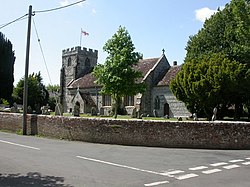Winterborne Kingston
| Winterborne Kingston | |
| Dorset | |
|---|---|
 St Nicholas, Winterborne Kingston | |
| Location | |
| Grid reference: | SY862976 |
| Location: | 50°46’43"N, 2°11’51"W |
| Data | |
| Population: | 643 |
| Post town: | Blandford Forum |
| Postcode: | DT11 |
| Local Government | |
| Council: | Dorset |
| Parliamentary constituency: |
North Dorset |
Winterborne Kingston is a village in Dorset, found seven miles south of the town of Blandford Forum and two miles northeast of Bere Regis. It stands in the valley of a winterbourne on the edge of the dip slope of the Dorset Downs. The 2011 census noted in the parish 282 households and a population of 643.
Description


Winterborne Kingston consists of Kingston, which is two thirds of the western area of the parish, and Turberville (later called Abbots Court Farm) to the east. Still further east is the hamlet of Winterborne Muston. The River Winterborne which flows through the village is a tributary of the River Stour.[1] As the name implies, the river tends to flow only in winter. Kingston means the King held land here, so the name of the village can be translated as 'Kings Land by the Winter Stream'.
Parish church
The village church is named after St Nicholas. It is in the Decorated style and faced with flint. The Victorian architect George Edmund Street remodelled the church in 1872.[2]
History
Icknield Street, a prehistoric route later used by the Romans, passes through the village, and Roman artefacts have been revealed here in ploughed fields.[3]
Dorset historically had many cottage industries related to the clothing trade. Button making (buttony) developed in the 1680s in the villages with Blandford the main centre. The 1851 census shows that many of the women in Winterborne Kingston were button makers Most of the men in this area worked as agricultural labourers. The farms in this area were small dairy farms, which supplied dairy products to the London markets. There were also limekilns, which were an important part of the agricultural scene as they produced lime for spreading on the land. Barley was one of the main crops, and was used in the production of malt for the brewing of beer in Dorsetshire and London Breweries. Other trades in the area were carpenters, bricklayers, blacksmiths and shoemakers.
About the village
Amenities in the village include the Greyhound Inn, the Church of St Nicholas, the village hall and a recreational ground (including a children's playpark).
Duropolis
- Main article: Duropolis
In July 2015, archaeologists discovered the Iron Age remains of what is believed to be Britain's oldest planned town near Winterborne Kingston.[4]
Outside links
| ("Wikimedia Commons" has material about Winterborne Kingston) |
References
- ↑ "Walking the River Winterborne". Dorset AONB Partnership, UK. 2011. http://www.dorsetaonb.org.uk/assets/downloads/Winterbournes_Wetlands/Winterborne_Leaflet_final_copy.pdf. Retrieved October 5, 2011.
- ↑ Nikolaus Pevsner: Pevsner Architectural Guides
- ↑ North Dorset District Council (c. 1983). North Dorset District Official Guide. HomePublishing Co. Ltd. pp. 53–55.
- ↑ Simon de Bruxelles (17 July 2015). "Pre-Roman town of Duropolis found under Dorset fields". The Times, UK.
